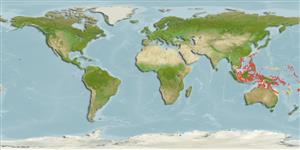>
Gobiiformes (Gobies) >
Gobiidae (Gobies) > Gobiinae
Etymology: Valenciennea: From Achille Valenciennes 1794-1865; he worked with Duméril, Cuvier and Lacepède since 1815; malacologist, author of a "Histoire naturelle des poissons" (Ref. 45335).
Eponymy: Achille Valenciennes (1794–1865) was a French zoologist; primarily an ichthyologist and conchologist. [...] Dr John ‘Jack’ Ernest Randall Jr. [...] (Ref. 128868), visit book page.
More on authors: Hoese & Larson.
Issue
Type locality: Solomon Islands, Guadalcanal, Honiara.
Environment: milieu / climate zone / depth range / distribution range
Écologie
marin; saumâtre récifal; profondeur 8 - 30 m (Ref. 48637). Tropical
Western Pacific: Ryukyu Islands, Philippines, Solomon Islands, Malaysia, Palau, Indonesia and the Great Barrier Reef.
Taille / Poids / Âge
Maturity: Lm ? range ? - ? cm
Max length : 16.0 cm SL mâle / non sexé; (Ref. 48637)
Épines dorsales (Total) : 6 - 7; Rayons mous dorsaux (Total) : 16 - 18; Épines anales: 1; Rayons mous anaux: 16 - 18. Characterized by pale grey body color with red and blue-edged blue-green stripe below eye; faint orange stripe along lower side; third dorsal spine longest and prolonged in adult; rhomboid caudal fin, longer than head; longitudinal scale series 76-81; ctenoid body scales, becoming cycloid below first dorsal fin; head or midline of nape without scales; side of nape with scales extending forward to above middle of operculum; fully scaled pectoral fin base and prepelvic area in adult; depth of body 5.0-5.9 in SL (Ref. 90102).
Inhabits coastal estuaries and muddy slopes adjacent to algal reef to about 30 meters depth (Ref. 48637). Solitary (Ref. 90102). Found in mud or fine silty sand bottoms, usually in the vicinity of its burrow.
Life cycle and mating behavior
Maturité | Reproduction | Frai | Œufs | Fécondité | Larves
Hoese, D.F. and H.K. Larson, 1994. Revision of the Indo-Pacific gobiid fish genus Valenciennea, with descriptions of seven new species. Indo-Pac. Fish. (23):71 p. (Ref. 8527)
Statut dans la liste rouge de l'IUCN (Ref. 130435: Version 2024-2)
Menace pour l'homme
Harmless
Utilisations par l'homme
Outils
Articles particuliers
Télécharger en XML
Sources Internet
Estimates based on models
Preferred temperature (Ref.
123201): 25.9 - 29, mean 28.2 °C (based on 358 cells).
Phylogenetic diversity index (Ref.
82804): PD
50 = 0.5000 [Uniqueness, from 0.5 = low to 2.0 = high].
Bayesian length-weight: a=0.01023 (0.00477 - 0.02194), b=3.01 (2.83 - 3.19), in cm total length, based on LWR estimates for this (Sub)family-body shape (Ref.
93245).
Niveau trophique (Ref.
69278): 3.2 ±0.3 se; based on size and trophs of closest relatives
Résilience (Ref.
120179): Milieu, temps minimum de doublement de population : 1,4 à 4,4 années (Preliminary K or Fecundity.).
Fishing Vulnerability (Ref.
59153): Low vulnerability (10 of 100).
Nutrients (Ref.
124155): Calcium = 81.2 [42.3, 159.4] mg/100g; Iron = 0.673 [0.340, 1.195] mg/100g; Protein = 18.7 [16.7, 20.3] %; Omega3 = 0.146 [0.069, 0.252] g/100g; Selenium = 21.7 [11.9, 46.2] μg/100g; VitaminA = 115 [31, 362] μg/100g; Zinc = 2.01 [1.40, 2.90] mg/100g (wet weight);
